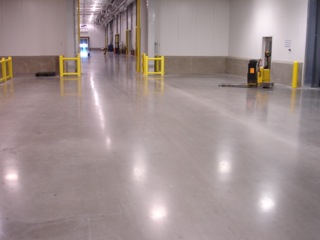The floors of food distribution facilities must endure a lot wear and tear, with heavy forklift traffic continually moving across the surface. As new warehouse facilities are being built, owners are choosing to invest in shrinkage-compensating concrete for the flooring, which eliminates control joints, reduces curling, and minimizes cracks.
Most flooring damage starts at the joints. With conventional concrete floors, joints are spaced every 10 to 20 feet to eliminate cracks from running the length of the floor. These joints are often filled with a semi-rigid epoxy, which presents inherent maintenance requirements. Made with an expansive cement, shrinkage-compensating concrete has 90 percent fewer joints than conventional floors.
The four main benefits of shrinkage-compensating concrete floors include:
1. Equipment protection — Forklifts can tear up a concrete floor, but they can also incur damage after repeatedly going over curled joints, spalled joints, and large cracks in the floor. Expansive concrete can actually reduce maintenance and extend the life of equipment, thus reducing operating costs.
2. Higher compressive strength — Shrinkage-compensating concrete inherently has a higher compressive strength, making it a much more durable option for large distribution facilities with heavy forklift traffic.
3. Reduced maintenance — The amount of joints are greatly reduced, requiring less maintenance on the floor. Reduced permeability, lack of curling, and increased resistance to sulfates also add to the durability of shrinkage-compensating concrete.
4. Employee safety — By eliminating cracks and joints, injuries to employees who drive forklifts (which often have no shock absorbers) are reduced. Improved safety has an impact on everything from productivity to workers’ compensation claims and premiums.
If you’d like to learn more about the benefits of shrinkage-compensating concrete flooring, email us a foodforthought@stellar.net or bsf@thefrickscompany.com.



